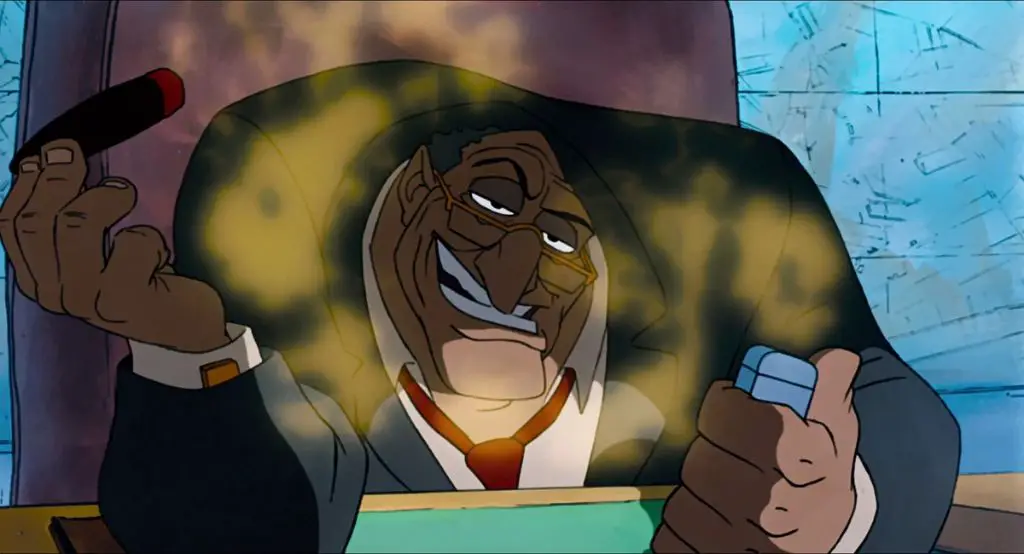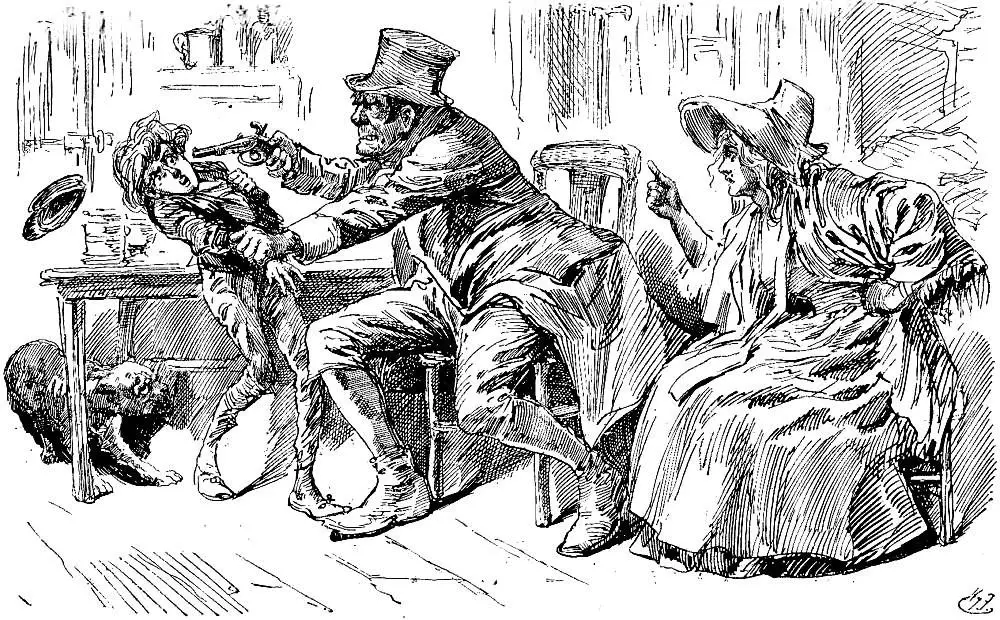Introducing Bill Sykes and Bullseye
Bill Sikes is a fictional character and the main antagonist in the 1838 novel Oliver Twist by Charles Dickens. Sikes is portrayed as a malicious criminal and murderer in the novel. According to the Wikipedia summary, he is a leader of a gang of thieves in late 1830s London and uses the young orphan Oliver Twist for pickpocketing.
Sikes’ vicious bull terrier, Bullseye, first appears in Chapter 22 when Sikes is introduced. Bullseye is described as an evil-tempered white dog who is used by Sikes to intimidate others. The dog is loyal to Sikes but displays aggression towards Nancy and others. Bullseye is used by Sikes to participate in criminal acts and attacks others on his command throughout the story.
Bullseye’s Breed
Evidence suggests that Bullseye was likely a Bull Terrier breed of dog. Bull Terriers originated in the early 19th century when bulldogs were crossed with terriers to create a breed that was strong and had a high pain tolerance, yet was also fast and agile for dog fighting and vermin hunting.
According to the American Kennel Club (AKC), the original Bull Terriers from the 1850s had larger heads more similar to the Bulldog. Overtime, selective breeding led to the unique “egg shaped” head that modern Bull Terriers are known for today. Other characteristics of the breed include a muscular body, pronounced shoulders, and a short, flat back. Their coats are short, dense and come in colors like white, brindle, and red.
As a vicious dog used for fighting, the name “Bullseye” ties directly into the Bull Terrier’s breeding origins and violent purpose. The breed name itself connects this dog to the story’s antagonist Bill Sykes, foreshadowing the evil acts they will carry out together.

Bullseye’s Vicious Temperament
Bullseye is portrayed as an extremely vicious and aggressive dog in Oliver Twist. Some examples of his aggressive behavior include attacking Oliver when he first arrives at Fagin’s den and later pursuing Oliver and Monks to try to attack them. Bullseye is also used by Bill Sykes to participate in criminal acts like robbery and intimidation.
In contrast, bull terriers are typically playful, clownish and mischievous dogs according to the American Kennel Club (https://www.akc.org/dog-breeds/bull-terrier/). Their temperament is described as gentle, affectionate and loyal. While they can be strong-willed, bull terriers are not inherently aggressive or dangerous.
Bullseye’s vicious demeanor in Oliver Twist is likely a result of intentional training by Bill Sykes to attack and participate in criminal behavior, as well as generally poor care and socialization. Sykes uses Bullseye for intimidation and violence, shaping the dog’s disposition through abuse and encouragement of aggression. With more positive reinforcement and training, Bullseye may have developed a temperament more in line with the typical traits of his breed.
The Symbolic Meaning Behind Bullseye
Bullseye, Bill Sykes’ vicious bull terrier in Oliver Twist, serves as a representation and amplification of his owner’s cruel nature. Dogs have long been used in literature as symbols or extensions of their human counterparts (Van Wagoner, 2020; “Dogs in Literature”, 2022). Just as the cruel and violent Sykes takes advantage of Oliver, Bullseye viciously attacks whoever his master orders him to.
The parallel between Bullseye and Sykes emphasizes how Bill Sykes lacks empathy, compassion, or morality. Bullseye’s breed as a bull terrier further symbolizes Sykes’ stubbornness and tenacity in pursuing his criminal objectives. Literary scholars note parallels between Bullseye and other villainous dogs in fiction, such as the violent Napoleon in Animal Farm or the ominous hound of the Baskervilles (“Symbolism”, n.d.). These creatures amplify the sinister traits of their masters, foreshadow danger, and serve as representations of human vices.
As critic E. Van Wagoner (2020) notes, “The violent tendencies of dogs like Bullseye ultimately reflect their owners’ cruelty and moral bankruptcy.”
Bullseye’s Role in Key Events
Bullseye plays a pivotal role in several key events in Oliver Twist. As Bill Sykes’s vicious guard dog, Bullseye is used for intimidation and violence. One of Bullseye’s first significant scenes is when he viciously attacks Oliver after the boy tries to run away from Fagin’s gang. Bullseye bites Oliver repeatedly, leaving severe injuries before Fagin pulls the dog away (1). This establishes Bullseye as a dangerous and violent animal early in the story.
However, Bullseye’s most critical involvement is in Nancy’s brutal murder. On Bill Sykes’ orders, Bullseye ruthlessly attacks Nancy, mauling her to death as Sykes beats her with a club. Bullseye obeys Sykes without hesitation, illustrating the dog’s savage nature. Nancy’s murder is a turning point in the novel, hardening Sykes as a cold-blooded killer and motivating Nancy’s friends to help Oliver against Sykes (2).
In the climactic scenes, Bullseye runs ahead of Sykes as he flees the police. Even with a gunshot wound, Bullseye desperately tries escaping capture. But his leash catches on a fence, and Sykes unintentionally hangs himself trying to free the dog. Bullseye’s tenacity to flee despite injury highlights his fierce loyalty to Sykes until the end (3). The dog’s death alongside Sykes provides closure after the violence Bullseye enabled.
Throughout the novel, Bullseye enables Sykes’ criminal acts through his viciousness. The loyal guard dog carries out ruthless attacks at his master’s bidding, playing an important part in the story’s most brutal moments.

(1) https://www.youtube.com/watch?v=RaDDlmJzfGc
(2) https://www.youtube.com/watch?v=fimDoKyelPc
(3) https://twitter.com/horror4kids/status/1666570594157035521
Pop Culture Depictions of Bullseye
As one of the most memorable characters in Charles Dickens’ Oliver Twist, Bullseye has been depicted in many film, television, and cartoon adaptations of the novel. Bullseye is the vicious dog owned by the antagonist Bill Sikes that is used to represent Sikes’ cruel nature. While the original novel leaves Bullseye’s breed unspecified, most adaptations portray him as a bull terrier to emphasize his strength and intimidating appearance.
In the classic 1948 David Lean film adaptation, Bullseye is depicted as a white bull terrier who snarls ferociously and adds to the tension in Sikes’ scenes. Similarly, in the Academy Award winning 1968 musical Oliver!, Bullseye is again shown as a white bull terrier who growls at Oliver. In the 1974 made-for-TV movie adaptation of Oliver Twist, Bullseye closely matches the description from the novel as a shaggy white mutt rather than a specific breed.
One noteworthy portrayal of Bullseye is in the 1988 Disney animated film Oliver & Company, where Bullseye is reimagined as a bulldog named Roscoe who belongs to the mob boss Sykes. Roscoe exhibits similar vicious tendencies as Bullseye, attacking Oliver at Sykes’ command. While the breed and name are changed, Roscoe serves the same symbolic purpose as in Dickens’ original story.
Overall, while some adaptations alter minor details about Bullseye, the core essence of the character as Sikes’ fierce loyal pet is retained in most portrayals across various mediums. Bullseye’s menacing presence continues to enhance adaptations of Oliver Twist just as in Dickens’ beloved novel. (https://ultimatepopculture.fandom.com/wiki/Bill_Sikes)
The Significance of Animal Cruelty
Bill Sykes’ abuse of his dog Bullseye reflects poorly on his character. In the 19th century novel Oliver Twist by Charles Dickens, Bill Sykes is portrayed as a vicious and brutal man who cares little for the suffering of others, whether human or animal. His cruel treatment of Bullseye serves to further illustrate his violent and abusive nature.
In the 19th century, animal welfare issues were just starting to gain more widespread attention. New laws against animal cruelty were being enacted, whereas such acts had largely gone unpunished in earlier times. For example, the Cruel Treatment of Cattle Act 1822 made it a crime in Britain to beat, abuse or improperly transport cattle [1]. Such legislation marked early milestones in recognizing animal welfare.
Additionally, researchers have established links between animal cruelty and domestic violence. People who abuse animals are more likely to also abuse human family members. By depicting Bill Sykes as an animal abuser, Dickens foreshadows Sykes’ ultimately murder of his lover Nancy [2]. His cruelty toward the helpless Bullseye reflects his generally violent nature.
Foreshadowing with Bullseye
Bullseye’s vicious and unpredictable nature serves as an important literary device for foreshadowing future events and character fates in Oliver Twist. As Bill Sikes’ dog, Bullseye mirrors his owner’s cruel tendencies, hinting at the violence that Sikes is capable of later in the novel. For example, early on when Sikes first appears with Bullseye, the dog is described as “looking up into his master’s face with a wistful air” as Sikes beats him, foreshadowing how Sikes will later abuse Nancy to death (https://www.sparknotes.com/lit/twist/foreshadowing/). Bullseye’s distrust and dislike of strangers also predicts how the characters who try to help Nancy, like Mr. Brownlow and Rose Maylie, will end up facing conflict with Sikes. Even the dog’s name, Bullseye, suggests themes of violence and targeting victims, foreshadowing Sikes’ later murder of Nancy.
Dickens’ use of Bullseye to symbolize and foreshadow is indicative of the broader symbolic role animals play in Oliver Twist. For example, Dickens associates the innocent Oliver with gentle animals like the wounded bird he helps at the beginning. In contrast, the villains like Sikes and Fagin are linked with predators like Bullseye, hinting at their true vicious natures. Through animal symbolism and characteristics, Dickens provides insight into the fates of various human characters.

Character Foil for Oliver
Bullseye serves as a stark contrast to the main protagonist Oliver Twist. While Oliver represents innocence and purity despite his difficult upbringing in the workhouse and among thieves, Bullseye epitomizes viciousness and cruelty, likely as a result of mistreatment by Bill Sikes.
As an orphan born into the lowest class of Victorian society, Oliver experiences destitution and hardships from birth (Victorian England Class Struggles). Despite his poor background and involvement with criminals, he maintains his morality and rejects corruption. Meanwhile, as Bill Sikes’s loyal companion, Bullseye enjoys status and privilege with his master but exhibits only violence and aggression.
Their opposite natures highlight the theme of nature versus nurture. While Oliver retains his dignity amidst corruption, Bullseye embraces cruelty perhaps shaped by his master’s influence. Their juxtaposition also underscores the class divides of 19th century England. Oliver represents the struggles of the underclass while Bullseye enjoys security with the anti-social villain Sikes (Victorian Era Social Classes).
Overall, Bullseye serves as a powerful foil and contrast for the good-natured orphan Oliver Twist, underscoring major themes related to morality and social class.
Final Analysis
In Oliver Twist, Charles Dickens uses the character of Bull’s-eye to reinforce key themes and add symbolic meaning to the story. As Bill Sikes’s vicious dog, Bull’s-eye serves as a representation of animal cruelty and mirrors his owner’s violent nature. Throughout the novel, Bull’s-eye’s presence foreshadows dark events and provides a sinister foil to the innocent orphan Oliver.
One of the main takeaways surrounding Bull’s-eye is the significance of animal cruelty in Victorian England. As an abused and aggressive dog, Bull’s-eye sheds light on mistreatment of animals during the time period. His harsh training and vicious behaviors reflect the darkest aspects of a corrupt society. Bull’s-eye also serves as a metaphor for the predatory nature of criminals like Sikes who exploit the helpless and vulnerable.
Furthermore, Bull’s-eye’s interactions with Oliver provide an important contrast between innocence and corruption. While Oliver represents purity and morality, Bull’s-eye embodies violence and vice. The fear Oliver feels towards Bull’s-eye underscores his helplessness and highlights the dangers facing an orphan in Victorian London. Yet despite Bull’s-eye’s dark symbolism, his loyalty to Sikes reveals traces of good even in characters meant to personify evil.

In his portrayal of Bull’s-eye, Dickens deepens the themes of innocence versus corruption, good versus evil. More than just a plot device, Bull’s-eye adds symbolism and foreshadowing that enrich the literary merit of Oliver Twist. Through this complex canine character, Dickens reminds us that there are often shades of gray even in a starkly black-and-white world.
